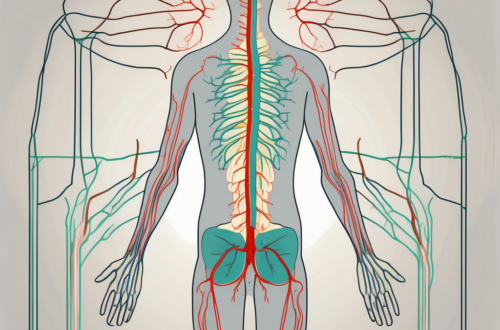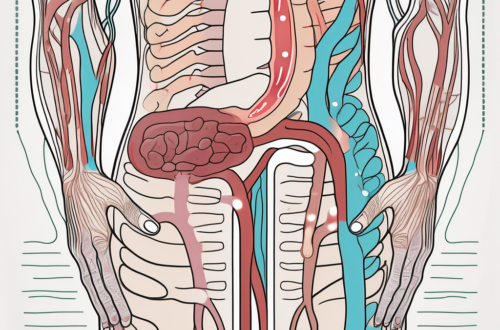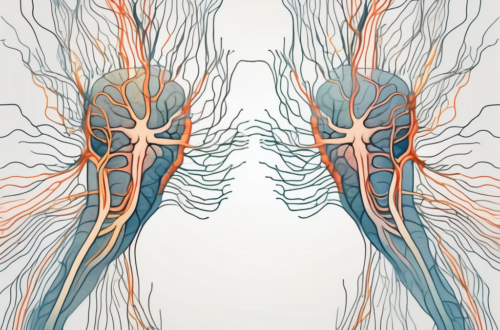The parasympathetic nervous system is a crucial component of our autonomic nervous system, responsible for the regulation of many bodily functions. Understanding the intricacies of this system is essential to comprehending its role in maintaining overall health and well-being. In this comprehensive analysis, we delve into the length of the parasympathetic nerve, exploring its anatomy, function, variables influencing its length, implications on health, and potential future research directions.
Understanding the Parasympathetic Nervous System
The parasympathetic nervous system is one of the two divisions of the autonomic nervous system, alongside the sympathetic nervous system. While the sympathetic system is responsible for activating the “fight or flight” response, the parasympathetic system acts to counterbalance its effects, promoting relaxation and restoration. It regulates various bodily functions, including heart rate, digestion, and glandular activity.
The Role and Function of the Parasympathetic Nerve
At the core of the parasympathetic system lies the parasympathetic nerve, which plays a pivotal role in transmitting signals between the brain and the organs it innervates. It helps maintain homeostasis by slowing down heart rate, increasing glandular secretions, and promoting digestion. By enhancing rest and recovery, the parasympathetic nervous system aids in the body’s rejuvenation and revitalization.
When the parasympathetic nerve is activated, it releases a neurotransmitter called acetylcholine. This neurotransmitter binds to specific receptors on target organs, triggering a cascade of events that result in the desired responses. For example, in the heart, acetylcholine slows down the rate of contractions, allowing the heart to beat at a more relaxed pace. In the digestive system, it stimulates the secretion of enzymes and increases blood flow, facilitating the breakdown and absorption of nutrients.
Furthermore, the parasympathetic nerve also plays a crucial role in the regulation of glandular activity. It stimulates the production and release of saliva, tears, and other secretions necessary for proper bodily function. This ensures that the body’s various glands are working harmoniously to maintain optimal health.
Anatomy of the Parasympathetic Nervous System
The parasympathetic nervous system consists of two main cranial nerves, the vagus nerve and oculomotor nerve, and three sacral nerves, S2-S4. The cranial nerves control the parasympathetic functions in the head and upper body, while the sacral nerves govern those in the pelvis and lower body. These nerves form intricate networks, connecting with various target organs to relay signals and facilitate the appropriate responses.
The vagus nerve, also known as the wanderer, is the longest cranial nerve in the body. It branches out extensively, reaching the heart, lungs, liver, stomach, and intestines, among other organs. This widespread innervation allows the vagus nerve to exert its parasympathetic influence over a wide range of bodily functions. It is responsible for slowing down heart rate, promoting digestion, and regulating the contraction of smooth muscles in the gastrointestinal tract.
The oculomotor nerve, on the other hand, controls the movement of the eye muscles and plays a role in pupillary constriction, which is the narrowing of the pupil in response to bright light. These functions are essential for maintaining clear vision and protecting the eyes from excessive light exposure.
In addition to the cranial nerves, the sacral nerves contribute to the parasympathetic control of the lower body. They innervate the bladder, reproductive organs, and the muscles involved in defecation. Through their connections with these organs, the sacral nerves ensure proper urinary and reproductive function, as well as efficient waste elimination.
Overall, the parasympathetic nervous system, with its intricate network of nerves and its role in regulating various bodily functions, is essential for maintaining a state of balance and well-being. By promoting relaxation and restoration, it allows the body to recover from the stresses of daily life and ensures optimal functioning of vital organs and systems.
Delving into the Length of the Parasympathetic Nerve
The length of the parasympathetic nerve can vary among individuals due to a combination of factors. Understanding these factors and measuring the length can provide valuable insights into the functioning of the parasympathetic system and its potential impact on overall health and well-being.
Factors Influencing the Length of the Parasympathetic Nerve
Several factors can influence the length of the parasympathetic nerve. Genetic predispositions, environmental factors, lifestyle choices, and aging processes can all contribute to variations in nerve length. While genetics play a significant role, external factors such as stress levels, physical activity, and dietary habits can also affect the development and maintenance of the parasympathetic nerve.
Genetic predispositions can determine the baseline length of the parasympathetic nerve. Some individuals may have naturally longer or shorter nerves due to their genetic makeup. This genetic variability can influence the overall functioning and responsiveness of the parasympathetic system.
Environmental factors also play a crucial role in shaping the length of the parasympathetic nerve. Exposure to certain chemicals, pollutants, or toxins can impact nerve growth and development. Additionally, living in a highly polluted or stressful environment can lead to chronic activation of the parasympathetic system, potentially affecting its length.
Lifestyle choices, such as physical activity and dietary habits, can directly affect the length of the parasympathetic nerve. Regular exercise has been shown to promote nerve growth and improve overall nerve health. On the other hand, a sedentary lifestyle can contribute to nerve degeneration and a decrease in length. Similarly, a balanced and nutritious diet can provide the necessary nutrients for nerve growth and maintenance.
Aging processes also play a role in the length of the parasympathetic nerve. As individuals age, there is a natural decline in nerve length due to various physiological changes. This age-related decrease in nerve length can impact the efficiency of the parasympathetic system and its ability to regulate bodily functions.
Measuring the Length of the Parasympathetic Nerve
Accurately measuring the length of the parasympathetic nerve is an ongoing challenge in scientific research. With advances in imaging techniques and neurophysiological assessments, researchers can now use various methods to estimate nerve length.
Magnetic resonance imaging (MRI) is a non-invasive imaging technique that can provide detailed anatomical information about the parasympathetic nerve. By capturing high-resolution images, MRI allows researchers to visualize the nerve’s structure and estimate its length. This method is particularly useful in studying the parasympathetic nerve in vivo, providing valuable insights into its health and potential abnormalities.
Electroencephalography (EEG) is another tool used to evaluate the length of the parasympathetic nerve. By measuring electrical activity in the brain, EEG can indirectly assess the functioning of the parasympathetic system. Changes in brainwave patterns can indicate the activation or suppression of the parasympathetic nerve, giving researchers an idea of its length and responsiveness.
Nerve conduction studies are commonly used to assess the health and length of nerves. By measuring the speed at which electrical impulses travel along the parasympathetic nerve, researchers can estimate its length and integrity. This method involves the placement of electrodes on the skin and the delivery of small electrical pulses to stimulate the nerve. The resulting electrical signals can then be measured and analyzed to determine the nerve’s length and functionality.
Combining these various methods can provide a comprehensive understanding of the length and health of the parasympathetic nerve. By unraveling the complexities of nerve length, researchers can further explore the implications for overall health and develop targeted interventions to optimize parasympathetic system functioning.
Implications of Parasympathetic Nerve Length on Health
The length of the parasympathetic nerve can have consequences for overall health and the proper functioning of bodily systems. Understanding the correlation between nerve length and specific diseases or conditions can provide valuable insights in the medical field.
The parasympathetic nervous system is a crucial component of the autonomic nervous system, responsible for regulating various bodily functions. It works in opposition to the sympathetic nervous system, which is responsible for the “fight or flight” response. The parasympathetic nervous system helps maintain homeostasis and promotes rest, relaxation, and digestion.
Research suggests that variations in parasympathetic nerve length may contribute to the development or progression of certain diseases, such as cardiovascular disorders, gastrointestinal dysfunction, and mental health conditions. Studies have shown that individuals with shorter parasympathetic nerves may be at a higher risk of developing these conditions. However, it is important to note that more research is necessary to establish conclusive links and determine the precise mechanisms underlying these associations.
One possible explanation for the correlation between parasympathetic nerve length and disease is the role of the vagus nerve. The vagus nerve is the longest cranial nerve and plays a vital role in the parasympathetic nervous system. It innervates various organs, including the heart, lungs, and digestive system. A longer parasympathetic nerve may provide better innervation to these organs, leading to improved functioning and reduced risk of disease.
Parasympathetic Nerve Length and Cardiovascular Disorders
Cardiovascular disorders, such as hypertension and heart disease, are major health concerns worldwide. Studies have suggested that individuals with shorter parasympathetic nerves may have an increased risk of developing these conditions. The parasympathetic nervous system helps regulate heart rate and blood pressure, and a shorter nerve length may impair its ability to maintain cardiovascular homeostasis. Further research is needed to fully understand the relationship between parasympathetic nerve length and cardiovascular health.
Parasympathetic Nerve Length and Gastrointestinal Dysfunction
The parasympathetic nervous system plays a crucial role in promoting digestion and regulating gastrointestinal function. Individuals with shorter parasympathetic nerves may experience gastrointestinal dysfunction, such as irritable bowel syndrome or gastric motility disorders. These conditions can lead to symptoms like abdominal pain, bloating, and irregular bowel movements. Understanding the impact of parasympathetic nerve length on gastrointestinal health can help develop targeted interventions and treatments.
Parasympathetic Nerve Length and Mental Health Conditions
Mental health conditions, such as anxiety and depression, are complex disorders that can significantly impact an individual’s well-being. Studies have suggested a potential link between parasympathetic nerve length and mental health. The parasympathetic nervous system helps regulate emotional responses and promotes relaxation. Individuals with shorter parasympathetic nerves may have a reduced ability to manage stress and may be more susceptible to developing mental health conditions. Further research is needed to explore this relationship and develop effective interventions.
The length of the parasympathetic nerve can also influence various bodily functions. For example, a longer parasympathetic nerve may be associated with improved digestive function, better regulation of heart rate, and enhanced overall well-being. However, further studies are needed to understand the complex interplay between nerve length and various physiological processes.
Future Research Directions in Parasympathetic Nerve Study
As we continue to unravel the mysteries surrounding the parasympathetic nerve’s length and its implications, several areas of further research emerge.
The parasympathetic nervous system, often referred to as the “rest and digest” system, is responsible for regulating various bodily functions, including heart rate, digestion, and relaxation. While we have made significant progress in understanding the role of parasympathetic nerve length in maintaining overall health and well-being, there is still much to explore.
Potential Therapeutic Approaches Targeting Parasympathetic Nerve Length
Understanding how parasympathetic nerve length affects health ultimately opens doors to potential therapeutic interventions. Modifications in lifestyle, such as stress reduction techniques, exercise, and dietary changes, may offer ways to optimize the length and functioning of the parasympathetic nerve.
For example, research has shown that engaging in regular physical activity can stimulate the growth and development of parasympathetic nerve fibers. This suggests that incorporating exercise into one’s daily routine may have a positive impact on parasympathetic nerve length.
Furthermore, certain stress reduction techniques, such as mindfulness meditation and deep breathing exercises, have been found to activate the parasympathetic nervous system, promoting relaxation and overall well-being. By incorporating these practices into daily life, individuals may be able to enhance the length and functioning of their parasympathetic nerve.
Additionally, dietary changes can also play a role in optimizing parasympathetic nerve length. Consuming a balanced diet rich in nutrients, such as omega-3 fatty acids and antioxidants, has been associated with improved nerve health. These nutrients can support nerve growth and repair, potentially influencing the length of the parasympathetic nerve.
However, it is essential to consult with a healthcare professional to develop an individualized plan. They can provide personalized advice and guidance based on an individual’s specific needs and medical history.
Unanswered Questions in Parasympathetic Nerve Research
Despite advances in parasympathetic nerve research, numerous questions remain unanswered. How does the parasympathetic system interact with other bodily systems? Can the length of the parasympathetic nerve be altered?
Exploring the intricate connections between the parasympathetic nervous system and other bodily systems is crucial for understanding the full extent of its impact on health. For example, recent studies have suggested that the parasympathetic nerve may play a role in immune system regulation and inflammation control. Further investigation is needed to uncover the mechanisms underlying these interactions and their implications for overall well-being.
Regarding the alterability of parasympathetic nerve length, current research suggests that while it may be influenced by various factors, including lifestyle choices, genetics, and environmental factors, the extent to which it can be actively changed is still not fully understood. Future studies should aim to explore the potential for targeted interventions that can promote the growth and development of parasympathetic nerve fibers.
In conclusion, the length of the parasympathetic nerve plays a vital role in maintaining overall health and well-being. With continued research and advancements in scientific methodology, we are gradually uncovering the intricate complexities of this essential component of the autonomic nervous system.
While we gain further insights into the implications of parasympathetic nerve length, it is essential to recognize the importance of consulting with healthcare professionals for personalized advice and guidance. They can provide evidence-based recommendations tailored to individual needs, ensuring the optimization of parasympathetic nerve length and overall well-being.





